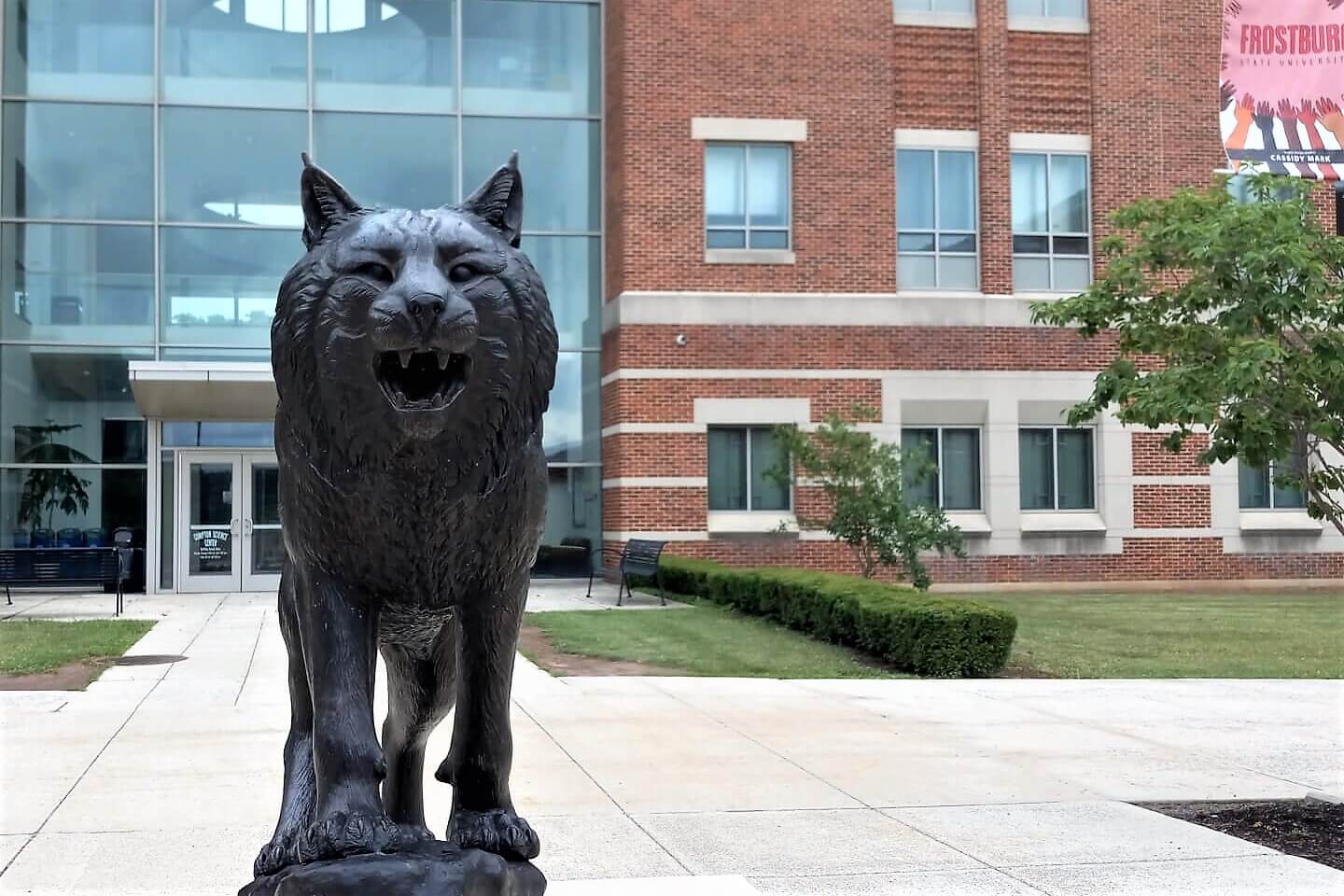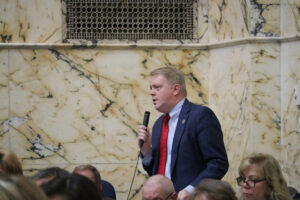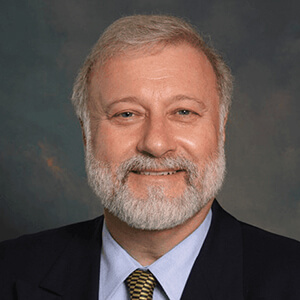In Md. Coal Country, a Push for Clean Energy — and a College Campus Leads the Way

“This is a region built upon rock solid layers of the determination of people who met every challenge head on. The challenges today are different, but the spirit of the people is the same. Western Maryland’s future is in the hands of the people who know about hard work — who know how to remove obstacles and pave the way — not just for themselves, but for those who will follow. Who know how to build roads that lead not only east and west, but also to the future.”
— Helen Jean Brown, local author, whose quote is on display at Frostburg Public Library.
****
Greg Barnett, a senior at Frostburg State University, grew up in Charles County and spent a lot of time visiting his grandfather in Washington, D.C., so Western Maryland is a different world for him. But he has come to love the mountains and the slower pace.
“It’s not city life,” he says. “I like that the area’s quiet. You can enjoy that the area’s quiet. It’s really beautiful. The air is so fresh.”
Until recently, Barnett had no idea that he was going to school in the heart of what had once been Maryland coal country. He doubts that many of the 5,600 students on campus know it, either.
“As a student at the university, I don’t think that’s something that I’ve ever heard anyone say,” Barnett concedes.
The far reaches of Western Maryland, including the hilly Frostburg State campus, are very much like the rest of Appalachia, where coal production has dominated the local economy for generations. But there’s very little evidence at Frostburg State that the university, which started in 1898 as a training school for teachers, later pitched itself as a place to educate the children of coal miners. In fact, visitors who approach the campus from the east, along Interstate 68, are greeted by the awe-inspiring view of wind turbines off on the horizon, which provides a different kind of impression — literally and figuratively — about the energy landscape in the region.
Not until Barnett began working to bring clean energy to the Frostburg State campus, in the early summer, did he realize that coal was once king in the region.
“In the short time I’ve been doing it, I’ve learned so much more about Frostburg,” he says.

Greg Barnett, a senior at Frostburg State University, is working on a project to bring a microgrid, powered by clean energy, to campus. Courtesy photo.
Barnett is an intern for Optimize Renewables, a company based in Hagerstown that serves as an adviser on clean energy projects across the globe. Last year, Frostburg State won a $100,000 grant from the Maryland Energy Administration to explore the possibility of setting up a microgrid on campus, fueled by renewable energy. And university officials hired Optimize Renewables to help them in that effort.
The microgrid proposal itself, if it comes to fruition, is fairly modest in scope. University officials envision setting it up to power critical campus operations in case of a major electricity outage in the region.
But symbolically, the project means a lot, and also says a lot, about the university’s — and the region’s — clean energy ambitions.
“It’s definitely a big deal for Western Maryland,” said Brandon Bowser, an energy program manager at the Maryland Energy Administration. “Not just for Western Maryland. It’s really become a show-stopper in the energy industry.”
‘It’s time to stop calling the same play’
Like almost all of Western Maryland and surrounding communities in West Virginia and Pennsylvania, Frostburg State is largely powered by coal, which for now remains a very cheap and abundant source of home-grown, Appalachian energy. But university officials and some of their allies in the region have big dreams. If the microgrid is set up, they hope to sell excess power to surrounding communities.
And Frostburg State is in the early stages of setting up a curriculum designed to train the clean energy workforce of the present and future, from local blue-collar workers to students earning engineering PhDs. One component of that curriculum would be offered to students on campus, for academic credit. The other half of the plan is to provide job training to members of the community — especially to workers in extractive industries who are looking to transition into clean energy work.
“Embedded in our genetic material is a desire to be involved in renewable and clean energy,” said Al Delia, vice president of regional development and engagement at Frostburg State.
There is still some coal mining in Western Maryland. Western Allegany County is home to a few small strip mines. In Garrett County, south of Grantsville, the Casselman Mine produces metallurgical coal for steelmaking and continues to employ about 100 people.
Additionally, there is a large coal-burning power plant on the outskirts of Cumberland, and there are still mining and coal plants in nearby counties in surrounding states.
Local civic leaders, including top officials at Frostburg State, consider the region to comprise five counties in three states: Allegany and Garrett counties in Maryland, along with Mineral County in West Virginia and Bedford and Somerset counties in Pennsylvania. And in this region, even the industry’s biggest boosters concede that clinging to coal is not a long-term proposition for economic prosperity.
“If I was king for a day, I believe coal can still be used, and used cleanly and efficiently,” said state Del. Jason C. Buckel (R-Allegany), whose district includes the Frostburg State campus. The fact that the Warrior Run coal plant on the outskirts of Cumberland is selling carbonation to soda companies as a byproduct of its electricity production, he argues, is a sign that coal can be safely used.
“When you’re producing food grade carbon, it means you’re doing enough to scrub the impurities out,” said Buckel, whose grandfather was a coal miner.

Del. Jason C. Buckel (R-Allegany). Photo by Danielle E. Gaines.
But the lawmaker, who recently was elected House minority leader in Annapolis, also realizes that talking about the virtues of coal is a losing political argument these days. “If you’re the quarterback, it’s time to stop calling the same play,” he said.
The fracking mirage
Some Western Maryland leaders thought the fracking of natural gas, which is taking place in neighboring Pennsylvania and West Virginia counties, represented a major economic opportunity for the region. But then Maryland in 2017 banned fracking, when Gov. Lawrence J. Hogan Jr. (R), to the surprise of Western Maryland politicians and business officials, sided with lawmakers who wanted to ban the controversial method of extracting natural gas from the earth.
That’s when Frostburg State administrators, in concert with local officials, decided to create a position of regional economic director. And that’s when Al Delia came on board.
“I’m the guy who’s the outward facing part of the university when it comes to things like sports, job training and boosting local economic development,” Delia says, explaining his role.
Delia had been an economic development official in North Carolina, leading a regional agency. He also served as secretary of the North Carolina Department of Health and Human Services and as a key adviser to former North Carolina Gov. Bev Perdue (D), and he held top positions at East Carolina University.

Al Delia, a vice president at Frostburg State University, is helping the university work on several regional economic development projects. FSU photo.
When he got to Frostburg, Delia started meeting with local stakeholders in the region, in and out of the energy sector, and he soon came to realize that the university campus — and the five-county region, would need to lean in to the clean energy economy. Delia soon got buy-in from key community leaders — and Frostburg State, under his leadership, has become more aggressively involved in economic development initiatives than before.
“It’s difficult to find an economic development project in the region that Al doesn’t have his toe dipped in, and I say that admiringly,” said Jennifer Walsh, executive director of the Greater Cumberland Committee, a regional nonprofit that focuses on economic development, infrastructure projects, workforce development, and education.
The Frostburg State clean energy agenda dovetails with regional leaders’ desire to diversify the energy economy.
“It’s something we want to embrace, because we want to be leaders in the state,” Buckel said.
There are already wind farms and solar arrays in Western Maryland — and more have been proposed. But when local leaders talk about the possibility of expanding renewable energy production, they also envision the area being home to biomass energy, green concrete production, waste-to-energy operations, coal ash conversion, and more.
But they know it isn’t an easy proposition, and they are looking in part to the university to lead the way.
“Repurposing our energy infrastructure is a tremendous undertaking,” said Shawn Bender, an executive with two local companies who leads the Greater Cumberland Committee’s energy and natural resources committee.
That group met with some regularity during the buzz over fracking, to discuss ways of optimizing the region’s economic position. But after Maryland banned fracking, those meetings gradually petered out.
The sessions resumed in 2019, after the Westvaco paper mill in Luke closed without much warning. The plant was a major employment hub for the area and its rusting, hulking industrial shell along the Potomac River served as a reminder to leaders that even with the region’s vast natural resources, the local economy was very fragile.
Bender, chief operating officer of Beitzel Corporation, an energy and construction company in Grantsville that began by servicing the coal industry 50 years ago, and COO of Pillar Innovations, a subdivision of Beitzel, felt conversations about the region’s energy future ought to continue.
Bender served on an a state advisory panel on the economic potential of fracking when former Gov. Martin J. O’Malley (D) was in office, and said he’s all too aware that there are natural tensions among various energy sectors in the region and that different regulatory regimes in Maryland, West Virginia and Pennsylvania shape the debate.
But, he said, “we aren’t here to fight against one another. We’re here to collaborate.”
Bender said the necessity for collaboration among the energy sectors “probably isn’t visible on the surface,” given their different priorities. But they have common goals and frustrations, too — including regulatory and permitting challenges and major infrastructure needs. And ironically, he said, the COVID-19 pandemic made it easier for energy sector leaders to begin meeting regularly, usually once a month.
“We’ve been able to get participation from people who wouldn’t otherwise be able to attend a meeting, because they’d have to travel,” he said. “They wouldn’t otherwise be in the same room together.”
‘Our focus is going to have to be on innovation’
Leaders of the Western Maryland energy sector are watching the Frostburg State projects very closely to see if they can serve as a template for diversifying the local energy economy. “Our focus is going to have to be on innovation,” Bender said.
Potomac Edison, the utility company for Western Maryland, continues to get most of its electric power — 82% — from coal, though that slowly will change: Potomac Edison’s parent company, First Energy, has a goal of generating carbon-neutral power by 2050, according to a spokesman, Will Boye. And it has an interim goal of a 30% reduction in greenhouse gas emissions for its power sector by 2030.
At the university, officials are enamored with the idea of coming up with a resilient source of electricity — in case Potomac Edison’s power goes out. They are concerned about emergency operations, like the campus police and food services, vital research in university labs that could be compromised or even wiped out in a power outage, and backup power for the university’s athletic center, which can be used as an emergency shelter for the broader community in case of natural disasters. So they began developing the concept for a microgrid on campus.
Last year, for the first time, the Maryland Energy Administration doled out $1 million in grants to 10 applicants as seed funding for resiliency programs; Frostburg State was awarded $100,000 for its microgrid.
“Historically, Maryland has imported most of our energy from out of state coal-fired power plants,” MEA Director Mary Beth Tung said in a statement at the time the grants were awarded. “The Resilient Maryland pilot offers a unique opportunity for innovation right here in Maryland across a variety of clean energy alternatives, reducing both financial risk and total project costs.”
After receiving the grant, FSU officials turned to Optimize Renewables, the Hagerstown-based international energy company, to help them with the next phase of the microgrid project, and gave the company’s CEO, Len Jornlin, the fancy title of “entrepreneur-in-residence.” Jornlin has vast experience in the clean energy tech space, and has also worked with several of the government and regulatory agencies that need to be engaged to make the Frostburg State project — and broader regional clean energy ambitions — succeed.
“We think it’s important to aid the transition from extractive industries to the clean energy economy,” Jornlin said.
Financing clean energy when coal is so cheap
Optimize Renewables now has a workspace on the Frostburg State campus — though because of COVID-19, the company’s staff has not been there very often. For now, company executives and FSU officials are putting final touches on a proposal for the microgrid. Among things they have to decide is how the microgrid will be powered beyond their general commitment to using renewable fuels.
Equally vexing is whether they will be able to get sufficient private sector investment to bring the project to fruition. Because coal power remains so cheap in the region, investors might not see the potential for return on investment in clean energy, and Jornlin said he believes a public-private partnership for funding the project is probably the best way to go.
“The private sector needs to step up and the public sector needs to step up,” he said.
Bowser, of the Maryland Energy Administration, said the agency intends to help. “In order to install those systems, you’ve got to have favorable financing,” he said.
Jornlin said the time is right for concentrating on clean energy development in Western Maryland — in part because the Biden administration seems committed to boosting and diversifying the Appalachian economy in ways that previous White House administrations weren’t.
“Stars are really aligning on this,” he said.
And Walsh, the director of the Greater Cumberland Committee, says business and civic leaders in the region see the wisdom of the Frostburg State project and are hoping it proves to be a catalyst for the expansion of clean energy in the region.
That puts pressure on Frostburg State officials to deliver on the microgrid project, Delia said — but they also sense the broader opportunity.
“The only way you can demonstrate the benefit is to build one and demonstrate it,” he said.
An evangelist for clean energy
Even though coal power is now cheap and abundant in the region, it isn’t clear how long it’s going to last. The Warrior Run coal plant in Cumberland is slated to remain in operation until 2030 — but other coal plants in Maryland have accelerated their closing or transition dates in recent months. The fate of another major coal plant nearby in West Virginia is also in doubt.
So that adds an element of urgency to what’s happening at Frostburg State and other efforts to bring clean energy to the region.
As for Greg Barnett, the Frostburg computer science student who has an internship with Optimize Renewables, he feels like he’s found his calling. He’s one of two student interns for the company, and was drawn to the project at the urging of Delia, the university vice president. Barnett says he previously worked with Delia setting up the website for the college economic development office, and “I knew if he was working with them, it would have been a good company.”
As a computer geek, Barnett is helping the company send surveys to students and the broader community about their personal energy habits, their awareness of the dangers of climate change, and what they’d like to see the proposed campus microgrid achieve.
Barnett concedes he never thought much about these issues until taking this internship. Now, he considers himself an evangelist for clean energy, and is telling classmates to get involved fighting climate change at the community level. And he hopes he can continue working for the company when he graduates in December.
“It’s important not just to see the journey but to be a part of it,” he says. “I’m in love with it, to tell you the truth.”






 Creative Commons Attribution
Creative Commons Attribution